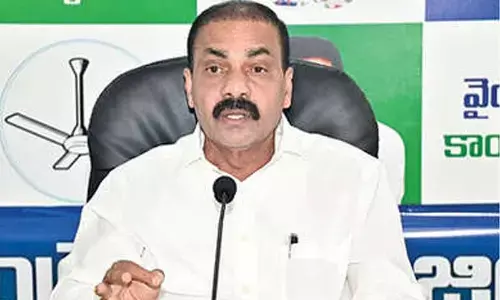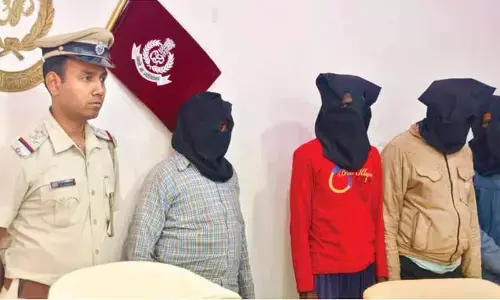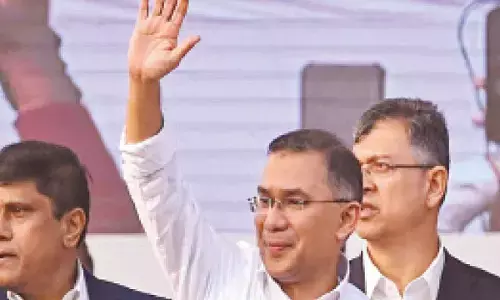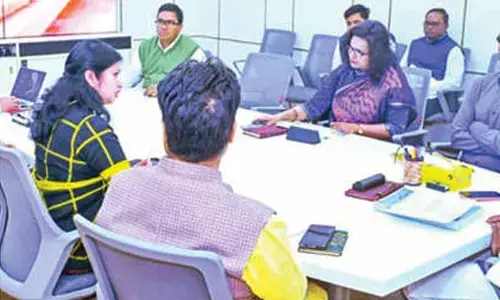Invaluable Inheritance

Invaluable Inheritance. Behind that serene and dignified demeanour is a world of wisdom, carefully cultivated and accomplished over time. All the while, the legacy of Kuchipudi is cherished with pride.
Dr Vedantam Ramalinga Sastry, one of the beacons of Kuchipudi heritage and Vedantam family has inherited not only the dance but also the responsibility to foster it for future generations
 Behind that serene and dignified demeanour is a world of wisdom, carefully cultivated and accomplished over time. All the while, the legacy of Kuchipudi is cherished with pride. Dr Vedantam Ramalinga Sastry was fortunate enough to have been born in the Vedantam family, one of the beacons of Kuchipudi heritage, and astute enough to realise the importance of taking it forward. Strict adherence to convention, immense respect for the culture that he was born into, and high esteem for the ethnicity that has nurtured him further strengthened his roots steeped in tradition. His rich contribution to the artistic wealth, his predecessors have built up, is praiseworthy.
Behind that serene and dignified demeanour is a world of wisdom, carefully cultivated and accomplished over time. All the while, the legacy of Kuchipudi is cherished with pride. Dr Vedantam Ramalinga Sastry was fortunate enough to have been born in the Vedantam family, one of the beacons of Kuchipudi heritage, and astute enough to realise the importance of taking it forward. Strict adherence to convention, immense respect for the culture that he was born into, and high esteem for the ethnicity that has nurtured him further strengthened his roots steeped in tradition. His rich contribution to the artistic wealth, his predecessors have built up, is praiseworthy.
Dr Vedantam Ramalinga Sastry is the Principal- Potti Sree Ramulu Telugu University and Sri Siddhendra Yogi Kuchipudi Kalapeetham at Kuchipudi village for the last ten years, besides being a dance director, a theorist and a choreographer.
He is the only person to document the entire resource of the ancient Yakshaganas. His persistent endeavour to propagate them while authoring and directing new works is laudable. He strives to act as a bridge between the old Vempati style of Kuchipudi and the new emerging trends.
Starting at the tender age of 13 (Bhookailasam – a yakshagana), developing his own style, he has scripted and choreographed more than 80 ballets, which include Kuchipudi Kelikas, Nrutya Roopakas, Javalis, Padams etc. He published over 100 articles and five books on Kuchipudi, his doctoral thesis being, ‘Telugulo Kuchipudi Nataka Vikasam’ ,( The Evolution of Kuchipudi Dance Drama in Telugu Literature ). He has travelled extensively abroad, performing, conducting workshops and spreading this beautiful dance form. His lifetime contribution won him many awards, including the prestigious Sangeet Nataka Academy Award in 2012.
While talking to him, one can clearly perceive his love for his village and his art.
His growing years and learning
“Our training was very tough. It was whenever, wherever and by whomever. All elders were our mentors and that is the reason why we have a long list of gurus. The whole village is one big dancing family. Any senior would summon us and say, “Come on, now show what you learnt yesterday, repeat that jathi” and we had to obey. Sometimes it was in the midst of a rice field on a slippery soil or in a field full of rough stones or temple premises. We had to demonstrate then and there and win their approval or get scolded or beaten for mistakes. In Kuchipudi Kalakshetra (dance school), we were made to bend maximum (for that perfect arai mandi) with the heavy school bags on our heads, to weigh us down. We learnt with so much “bhayam and bhakthi” (fear and respect) and that is why we still retain our initial training till date. Our gurus tried to give us maximum exposure, besides rigorous training. We were made to watch films of late Vempati Pedda Satyam to note how he adapted the Kuchipudi steps in his choreographies. Whenever it was a performance by Vedantam Satyanarayana Sarma (his uncle), we used to go and sit right in the front, so that we could minutely observe his facial expressions. Nowadays, one guru doesn’t send his pupils to watch another guru’s performance. A wide exposure helps in building choreographic skills.”
“We were a family of six brothers, and I being the youngest, received the best of all my siblings could offer, by way of training. My second eldest brother Vedantam Venkata Chalapathy Sastry, being a mrudangam player, gave us a great foundation in thalam (rhythm), making us practice for three hours everyday. He used to patiently explain the correlation between mrudanga sastram and Kuchipudi natyam and insist on mastering the talam aspect. Then my brother Radhe Shyam also taught me.”
“Our village had some great scholars and they used to hold discussions in the temple on various subjects. I used to sit on the steps and listen to them (between ages 6-10). Later at home, I would ask my father (who was most of the time immersed in reading the scriptures) to clarify my doubts. He used to lovingly clear all my doubts”. Certainly, true art thrives, nurtured on such beautiful bonds!
His Mission
“At 15 I left my village, to pursue higher education and later took up a job and settled well in Hyderabad. At 41, when I was called to head the Kuchipudi Kalapeetam, I went back to my village with a fond hope, to contribute and further develop this art, but to my disappointment, it was no more the village I knew. The art form has changed and so have the artists and their values. Anyway, last ten years I have been working hard to train about 25 people to be scholars and they can now write essays and participate in serious discussions with authority on the subject. Before I retire, I would like to see at least 25 books to be published on the subject.
I have revived the Siddhendra Aradhana Utsavam that takes place every Krishnashtami, where there will be a ceremonial procession, followed by Sahitya Charchalu ( Literary discussions) on dance. I believe in “Taurya Trikam”- Moodu Vidyala Sammelanam, which is a confluence of three arts: Sangeetham, Sahityam and Natyam ( music, literature and dance). These three arts should merge with each other, for best results.”
The present state
“Today’s dancers have excellent presentation skills in a performance. They repeat beautifully what they are taught, but lack in originality. They are very intelligent and quick in learning. We should appreciate that in spite of demanding studies and busy schedules, they are able to pursue dance.”
On the current trend of innovation
“Innovations should be healthy, based on the foundations of Kuchipudi, within the boundaries and with a thorough understanding of tradition. The best example for this is Vempati Chinna Satyamgaru. No one can pinpoint a single flaw in his dance/choreographies.”
The dancer
He is a different person on the stage, fully immersed in the character, be it a lecherous Keechaka or a cruel Hiranya Kasyap. He feels blessed that his wife Bhavani sings and does the nattuvangam during his dance dramas, giving him inspiration and moral support. His sons Satya Phani Dattu ( a budding vedic scholar ) and Vaghdevi Prasad, are both into dance, while the latter has taken after the mother and is also into music. Thus the Kuchipudi family treads, with graceful steps, on the path of tradition.




















